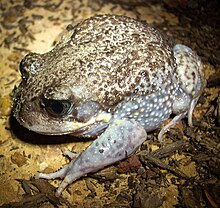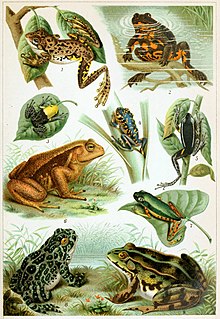
A frog is any member of a diverse and largely carnivorous group of short-bodied, tailless amphibians composing the order Anura. The oldest fossil "proto-frog" appeared in the early Triassic of Madagascar, but molecular clock dating suggests their origins may extend further back to the Permian, 265 million years ago. Frogs are widely distributed, ranging from the tropics to subarctic regions, but the greatest concentration of species diversity is in tropical rainforest. There are about 7,300 recorded species, which account for around 88% of extant amphibian species. They are also one of the five most diverse vertebrate orders. Warty frog species tend to be called toads, but the distinction between frogs and toads is informal, not from taxonomy or evolutionary history.

Limnodynastes dumerilii is a frog species from the family Limnodynastidae. The informal names for the species and its subspecies include eastern or southern banjo frog, and bull frog. The frog is also called the pobblebonk after its distinctive "bonk" call, which is likened to a banjo string being plucked. There are five subspecies of L. dumerilii, each with different skin coloration. The species is native to eastern Australia. There has been one occurrence in New Zealand, when tadpoles of the species were found in 1999 and destroyed.

The giant burrowing frog or eastern owl frog is a large frog species that occurs in coastal south east New South Wales and Victoria in Australia.
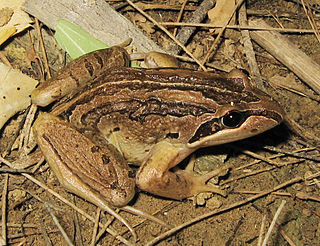
Limnodynastes is a genus of frog native to Australia, southern New Guinea and some Torres Strait Islands. They are ground-dwelling frogs, with no toe pads. The size varies from 45 mm to 90 mm in the giant banjo frog. The webbing on the feet ranges between species, from very little, to almost complete. The tympanum is not visible in any species, except in the woodworker frog, which is sometimes classed in a separate genus Megistolotis. All species construct a foam nest in which the eggs are laid. However, in south-eastern South Australia female striped marsh frog and spotted grass frog lack the flanges of skin on the hands that helps trap the air bubble and do not construct foam nests.

Pseudophryne is a genus of small myobatrachid frogs. All of these frogs are small terrestrial frogs, and as such, most species are commonly called toadlets. The genus comprises thirteen species, ten from eastern Australia, and three from Western Australia. Species within the genus Pseudophryne lay their eggs on moist ground. The tadpoles develop within the eggs, and once they reach hatching size, will become dormant. Once sufficient rain occurs to flush the eggs into a creek or river, the eggs will hatch and release tadpoles into the water. Many of the species within this genus have the ability to form hybrids.

Breviceps is a genus of frogs in the family Brevicipitidae. Species in the genus Breviceps are commonly known as rain frogs or short-headed frogs. They occur in arid to semiarid climates of East Africa and Southern Africa.

Myobatrachidae, commonly known as Australian ground frogs or Australian water frogs, is a family of frogs found in Australia and New Guinea. Members of this family vary greatly in size, from species less than 1.5 cm (0.59 in) long, to the second-largest frog in Australia, the giant barred frog, at 12 cm (4.7 in) in length. The entire family is either terrestrial or aquatic frogs, with no arboreal species.

Neobatrachus is a genus of burrowing ground frogs native to Australia. They occur in every state except Tasmania, however this genus is absent from the far north of Australia and most of Queensland. Most of the species in this genus occur in south-western Western Australia. They are often found in arid areas and burrow underground to avoid dehydration. They are typically found in temporary claypan and flooded grassland habitats.
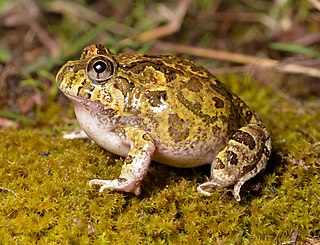
The ornate burrowing frog is a species of ground frog native to Australia. It was moved to the genus Opisthodon in 2006, following a major revision of amphibians, and is now classified in the genus Platyplectrum.

The northern sandhill frog is a small, fossorial frog native to a small region of the Western Australian coast. It was formerly considered the sole species within the genus Arenophryne until the first decade of the 2000s, when a new species of frog called the southern sandhill frog was discovered about 100 kilometres from Geraldton, Western Australia in Kalbarri National Park and given the scientific name Arenophryne xiphorhyncha.

Ranoidea australis, commonly known as the giant frog, northern snapping frog, or round frog, is a burrowing species native to Australia. It occurs from western Queensland through to northern Western Australia.

Metacrinia is a genus of frog in the family Myobatrachidae. It is monotypic, being represented by the single species, Metacrinia nichollsi, commonly known as the forest or Nicholls toadlet. It is endemic to Southwest Australia, occurring between Dunsborough and Albany.

The moaning frog is a burrowing frog native to south-western Western Australia.

The Sudell's frog, painted burrowing frog, trilling frog or desert trilling frog is a species of burrowing frog common to a large part of southeastern Australia. It is found on and west of the Great Dividing Range of New South Wales to western Victoria and southern Queensland as well as far eastern South Australia.

The long-thumbed frog, Fletcher's frog or barking marsh frog is a species of non-burrowing ground frog native to south-eastern Australia. The species belongs to the genus Limnodynastes. The twelve species in the genus are characterised by a lack of toe pads. Following phylogenetic analysis, the species was placed in L. peronii clade group alongside L. depressus, L.tasmaniensis and L. peronii.

Spencer's burrowing frog is a species of frog native to western and central Australia.
Ranoidea vagitus, the wailing frog, is a tree frog occupying the arid and monsoonal Kimberley region. It is a ground dweller, which evades dry periods by burrowing and hibernating - emerging to breed during floods.
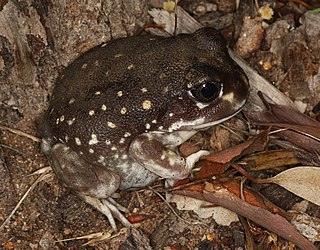
The western spotted frog is a species of frog in the family Limnodynastidae. It is endemic to Western Australia. Its natural habitats are temperate forests, temperate shrubland, intermittent rivers, freshwater marshes, rocky areas, granite outcrops, arable land, pastureland, open excavations, and canals and ditches. It is threatened by habitat loss and salinity.
The hooting frog is a species of frog in the family Limnodynastidae. It is endemic to Australia. Its natural habitats are temperate forests and intermittent rivers.
Burrowing frog may refer to several fossorial frog species:
